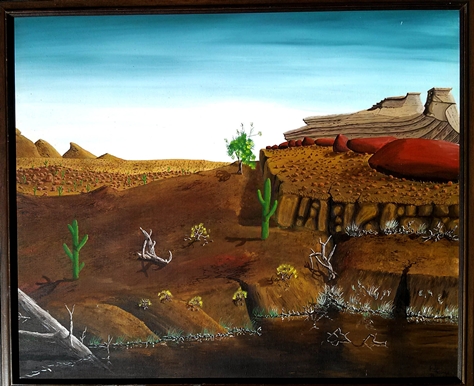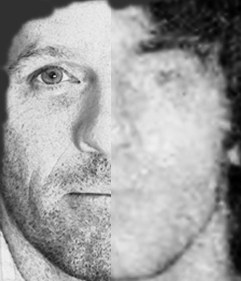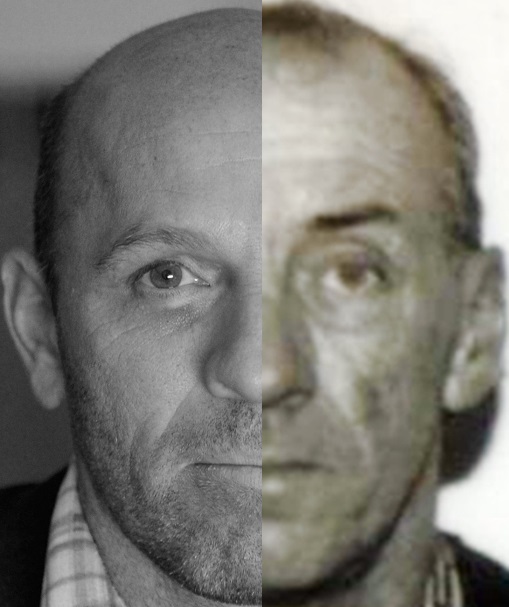
When retired correctional officer Bob Fletcher was told the painting he bought off a teenage inmate in the mid-'70s could be an original Peter Doig, he was flabbergasted. The surrealist painting he had bought for $100 was signed by Pete Doige, a gifted young man who was serving time for a drug charge, whom he hadn't heard from in decades. Peter Doig, on the other hand, is one of the world's leading contemporary artists whose paintings have sold at auction for up to $12 million. But when Fletcher contacted Mr. Doig, the famed artist's agents denied he'd ever painted it, or that he'd ever served time in the Thunder Bay Correctional Facility where Mr. Fletcher had worked. In an earlier article, I detailed the increasingly bizarre coincidences that led Mr. Fletcher to become convinced that notwithstanding their denial, Mr. Doig was in fact the artist he had bought the painting from. And that's when the story got weirder.
Shortly after publishing my piece on the painting, Peter Doig contacted me. He did not deny painting the painting, and instead focused exclusively on the signature. He wrote, "Not that it matters as far as me being the artist . . . But if it's a Noige or a Doige . . . Looks like Pete Noige to me." [ellipses Mr. Doig's] I replied that if he had not painted the painting, the coincidences were so strong that the only alternative explanation was that someone might have been trying to perpetrate a hoax and was using his name and reputation to profit. If that was the case, I told Mr. Doig, then that was a story I would pursue. But Mr. Doig never replied, and the story seemingly disappeared. Until, that is, this summer, when Mr. Fletcher and his agent, Peter Bartlow, of Bartlow Galleries which has listed the painting for sale, filed suit against Mr. Doig and his agents in U.S. District Court.
The response from Mr. Doig and his agents was swift and forceful. They countered that not only did Mr. Doig not paint the painting, but that Fletcher and Bartlow were only seeking publicity and profit and should be sanctioned for failing to conduct any investigation of the matter before filing suit. Moreover, they alleged that the plaintiffs knew Mr. Doig and Peter Doige were two different people and knowingly made a false claim.
Then, shortly later, Mr. Doig's attorneys produced a sworn Affidavit from Marilyn Doige Bovard, dated August 26, 2013, declaring that it was her deceased brother who had painted the painting. Ms. Bovard indicated that her brother, Peter Doige, was born in April of 1955 and died in February of 2012, shortly after the issue of the painting's authenticity had come to light. She declared that as a youth he had been sent to jail for a crime he had committed in Sudbury, Ontario. She further indicated that she recalled he had told her he had taken art and music classes while serving time in Thunder Bay. She attached a driver's license, union I.D., and a college I.D. from Lakehead University, swearing that that the photos were those of her deceased brother. The Lakehead University I.D. photo, below, was the only one from the mid-1970's, while the other two were more recent.

I sent the photo to Peter Doig and asked if it could possibly be him, and he replied that it was not him. He further stated that the only coincidences he found between himself and Peter Doige were that they shared four letters of the same name and both lived in Canada. He made no mention of their shared artistic talents.
Ms. Bovard's declaration stated, "Throughout his life, my brother did music and art. I have some of Peter's other works that he painted before he passed away. One is a desert scene, painted in acrylic on what appears to be linen which is approximately 36" x 20". Another is a fantasy-type image of a lady with her hair flipped back, which has also been painted in acrylic and is approximately 12" x 20". These works are in storage in my possession."
Regarding the painting in question, Ms. Bovard's declaration swore that she believed the painting to be her brother's, that he had lived in Arizona as a youth, and that she recognized the saguaro cactus in the painting. Finally, her Affidavit included this photograph of the artist Peter Doig, which she said was not her brother, adding, "I have never met the person whose photograph appears below."

One look at the photo from the Lakehead University I.D. and both Bob Fletcher, and former Thunder Bay art teacher Ernie Adams concurred--that was the young man they knew.
It appeared that the case was closed--famed artist Peter Doig had nothing to do with the painting, had never served time in Thunder Bay, and had had his name and reputation smeared, endured a frivolous legal proceeding, and was subjected to costly legal and investigative fees to prove he wasn't somebody else.
The only problem was, as Ernie Adams noted, the photo of the young man, and the photo of Peter Doig, are remarkably similar. So similar, in fact, that when the photo of young, now deceased "Peter Doige," is aligned with the photo of the middle-aged, very much living Peter Doig, they are a perfect match.

If Ms. Bovard's Affidavit is to be believed, her brother and Mr. Doig not only shared nearly identical names, they were close in age (Peter Doig was born in April of 1959; Peter Doige in April of 1955), had lived in the same region of the same country at the same time, were both remarkable painters with a penchant for LSD and both had faces so eerily similar that they could have been separated at birth. What are the odds? Well, they get even odder.
A driver's license provided by Ms. Bovard of her deceased brother bears remarkable resemblance to the living Peter Doig, had he lived a much rougher life. There is the distinctively square jaw line, the bulbous nose, and the hair loss. But it does not appear to be the same man.

Adjusted for pixel size and placed side by side, the living Peter Doig and the deceased Peter Doige are clearly two different men, yet eerily similar.

Other than the obvious difference in how the two men have aged, while their features line up, they are subtly but distinctly different. Could they be related? Or do we see only what it is that we expect to see, whether in a photo or a painting?
Bewildered, I contacted Mr. Doige's mother, whose name I won't print here to protect her privacy. She indicated to me that she was so stressed from the recent revelation that her son had served time in prison and was now the subject of a lawsuit, that she had suffered a recent stroke. Although she was estranged from him, she confirmed that her son had been a painter, was born in April, and had died last year. She also indicated that he had never been to Lakehead University, and she never knew he had served any time in a correctional facility. But she did not have any photos of her son since his childhood, she told me, and said that her daughter was handling all the inquiries from the press and didn't wish to discuss the matter further.
I then contacted her daughter, Ms. Bovard, who told me that the matter came to her attention this summer when a private investigator from California visited her at her home in Alberta, Canada. She confirmed that the photo on the Lakehead University I.D. was of her brother, and said that she found the I.D. card in his wallet after his death. "That's the funny thing," she pondered, "why does someone hang on to something like that for so many years? Obviously it meant a lot to him."
"I do know that he had attended Thunder Bay University," she volunteered, "and I do know that at one point he worked for some kind of longshoreman, something or other. My brother left home at 15 when we were living in Florida and my dad caught him smoking cigarettes and gave him an ultimatum and he left."
Although she and her brother had been estranged for many years since their childhood, they did resume their relationship about twenty years ago, she explained, but her brother struggled with drinking and died of hepatitis and cirrhosis of the liver. She said she visited him frequently, but didn't have any other photos of her brother, other than the I.D.'s.
"As a young boy he would draw with rulers and stuff," she said, "and then he got into music." In her Affidavit, Ms. Bovard had said that she had in her possession some of her brother's paintings, and they had been done in acrylic on linen. When I asked her how she knew what medium was used to paint them, she said because she had them in her possession. Still, since she was not an artist herself, how did she know the medium and canvas? "I just kind of knew. I don't know why I knew, I just knew," she answered. But she is confident the painting is her brother's, although she concedes it is different from some of the other things he had done. Nonetheless, she indicated that after being thrown out of his father's house in his teens, he spent some time living with his mother in Arizona, where saguaro cacti are common.
I then contacted Peter Doige's stepsister, Shirley Cox, who said she never knew her stepbrother very well, but found it hard to believe he had any artistic talent, laughing at the thought. "He was a bad drug addict," she said, adding that she hadn't seen him in twenty years. "I never knew of him doing any painting. . . . The only thing that sounds like him would be the correctional facility."
In 1973, a young 18 year old man named Peter Doige from Arizona was arrested for armed robbery in Sudbury, Ontario, when the deceased Peter Doige would have been 18 years old. What Ms. Bovard recalls about her brother during this period, she said, was that he later told her he had lived in Thunder Bay and Toronto, and got into the local music scene there. After that, he worked for oil rigs, she recalled, then became a carpenter, until he went through some hard times and became nearly homeless. Yet Ernie Adams, the art teacher in Thunder Bay, remembers the young man who did the painting as driven and ambitious. Curious, I had asked Ms. Bovard if that described her brother. "Yes," she readily noted, "it does." Yet little in his life indicates that Peter Doige was either artistic or ambitious.
"Peter would never tell us about why he couldn't go to the States to visit, but then this whole thing came out about why he had served time and it was a drug thing. I would very much like to get his files but then, whose files would I be getting?" she wonders. She then points out that if Peter Doig was four years younger than her brother, he would have been a juvenile at the time the painting was done. "Why wasn't he in a juvenile facility?"
It's a good question. If her brother had done the painting in 1976, he would have been 20 at the time of the incarceration, turning 21 in April, and would not be in a juvenile facility. And if Peter Doig, the famed artist, had done it, he would have been 16 at the time of his incarceration, turning 17 in April, before his release which Bob Fletcher recalls was later in the spring or early summer.
Could it be that, as Mr. Doig's attorneys allege, Fletcher and Bartlow are so eager to profit from the painting that they are knowingly leaping to a ridiculous conclusion and ignoring the evidence that demonstrates Mr. Doig had nothing to do with the painting and is being unfairly smeared?
Could it be that, as Bob Fletcher and Peter Bartlow allege, Peter Doig did indeed paint the painting and is trying for whatever reason to hide a past that is hardly scandalous, given the prevalence of drugs in the '70s and the minor nature of the offense?
Or could it be that sometime in the mid-'70s a bright young man, under legal age and wanting to appear a few years older, faked an I.D. based on someone else's identity? Doig's biographer, Adriane Searle, has stated in his biography of Doig that "he faked an impressive array of high school qualifications that he did not in fact possess." If he had faked his I.D. to appear older, it would have been a relatively innocuous act at the time, after finding someone with nearly the same name, born around the same time, perhaps a not-so-distant cousin. By showing a few legitimate documents bearing a "misspelled" name, a young boy could easily obtain a photo I.D. under the older boy's name, and retain the identity once arrested. After serving time, he could effortlessly revert to his original identity and, not so effortlessly, launch a spectacular and untarnished career.
It is but one possibility, emerging from a convoluted tale of two young men whose diverging lives have now collided to create a potentially multi-million dollar mystery. But it is a possibility that might explain the seemingly inexplicable, with an initial denial by the artist that was expected to make the matter simply go away, but instead rapidly snowballed when the owner of the painting went first to the media, and then to the courts.
I don't know the answer, but one thing I do know, the story has become more surreal than the desert landscape that started it all.
